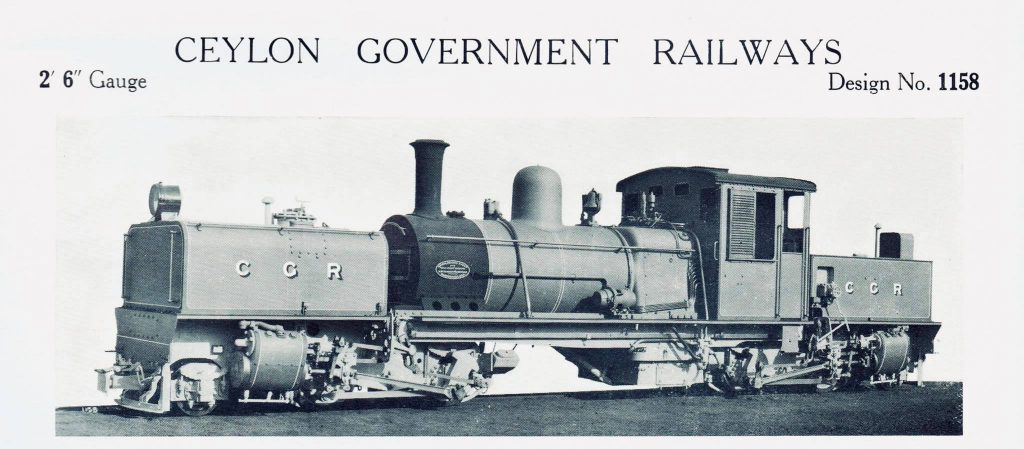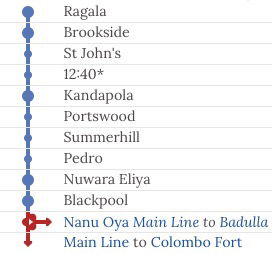Originally, narrow gauge railways were used in three sections of Sri Lanka where sharp curves were available due to the geography of the region. The main difference of narrow gauge was the width of the track: for narrow gauge the standard was 2 feet 6 inches while for broad gauge it was 5 feet 6 inches.
Originally these type of railways were used way back in 1906 connecting broad gauge from Nanu Oya to Ragala via Nuwara Eliya, popularly known as Uda Pussellawa Railway (UPR) or Udupussallawa Railway. However, among the narrow gauge lines the longest line was laid along Kelani Valley, which lasted for a long period for close to a century and popular one.
The Nuwara Eliya railway line was an exclusion for tourism and freight.
Ceylon railway construction started in 1858, Nanuoya to Nuwara Eliya line (UPR) started in 1900. The golden era of the Ceylon railway is considered to be from 1858 to 1927. In the year 1927, Ceylon Government Railway has completed paving 951 miles of railway lines. According to the book ‘Railway as factor in Socio-Economic Changes in Ceylon’, the most important part of income generated by the railway was 28.8% of total GDP of the country in the golden year of 1927.
Resource extraction, population inclusiveness were the main factors behind the development of railway in Sri Lanka, in terms of freight and passenger transportation. The railway commission has understood that the traditional railway lines which is the gauge of 5’6” cannot be laid in every part of the country, especially in high altitudes.
Furthermore, they have introduced narrow gauge line of 2’6” in high altitude areas, which is in the model of ‘Darjeeling line’ which was paved in the Himalayan Ranges in India. Considering the above Himalayan Darjeeling concept, the Ceylon Government Railway (CGR) decided to start the Kelani Valley Line (KV line) from Colombo to Opanayake in the Ratnapura District, which is a narrow gauge line, established in 1902.
There was a proposal to introduce Tramways to Nuwara Eliya, but unfortunately, the Hill Tramway Commission rejected the proposal and iterated the light railway which is the narrow gauge line was the most suitable transport mode to UPR line.
The closest station to Nuwara Eliya on the existing heavy gauge railway line (Main Line) was Nanu Oya railway station. The distance from Nuwara Eliya to Nanu Oya was approximately 6.4 km (4.0 mi) and colonial planters in Nuwara Eliya faced many difficulties when transporting goods from Nanu Oya to Nuwara Eliya.
Due to the introduction of railway in 1885 by CGR, Udapussellawa Planters Association requested the narrow gauge line from Nanu Oya to Nuwara Eliya, which is 12.4 miles from the British governor Sir West Ridgeway, who was on a trip to Nuwara Eliya on 25 April 1895. The Governor proposed to Colonial Secretary Noel Walker about the above request from Udapussellawa Planters Association many times and the Colonial Secretary had rejected the request considering that the line is not economically viable.
But Governor West Ridgeway was determined to continue the concept since he can transport and export the produce at Nuwara Eliya, Kandapola, Ragala and Mathurata areas which supplied the finest tea specialties in Sri Lanka. The Nuwara Eliya Assistant Government Agent C.M. Lashinton proposed another narrow gauge line from Talawakelle to Diyagama which was not activated.
Subsequently, he delivered his first speech at the Colonial Secretariat under the theme of ‘Extension of Roads and Railways of Ceylon’ in 26 October 1896, even though the Colonial Secretary was against the principle due to the geography and toughness of the railway line, which is one of the toughest in the world.
The Nuwara Eliya narrow gauge line would have been one of the best modes for the tourism development in the country
As for elaboration, the distance of Nanuoya to Nuwara Eliya is 6.45 miles and altitude difference is 1,000 ft. Therefore, the gradient of the line could be 1:23 feet. Also, there were bends with the radius of 80 ft. However, the Governor was determined to start the construction of the line without the consent of the Colonial Secretariat.
On 14 December 1903, the Governor completed 12 miles of the railway line as the first stage up to Nuwara Eliya. It was opened by by Sir Henry Blake. Due to this the Colonial Secretary agreed to allocate funds for the project. Subsequently, the line was extended to Kandapola and Ragala on 1 July 1904 for cargo transportation. The cost of construction was about £5,500 per mile.
After testing with cargo for a few months, CGR started operations for passengers on 25 July 1905. There was a proposal to convert the UPR line to electricity in 1927 according to the book ‘Railways of Sri Lanka’.


Route Map of UPR 
Train ticket from Watagoda to Nuwara Eliya.
The tickets were made in two parts as the station in Nanu Oya worked as a transit from broad gauge (Main Line) to narrow gauge (UPR)
The line was constructed in 2 ft 6 in (762 mm) gauge. The total length from Nanu Oya to Ragala was 31 km (19 mi), and five main railway stations were built on the line: Blackpool, Nuwara Eliya, Kandapola, Brookside and Ragala. The highest elevation on the line was at Kandapola railway station. Its elevation was 1,925 m (6,316 ft) above sea level.
CGR had started this project with four engines prepared by a British company called the Shark Stewart Company and they have named the Engine Model as UPR Class L1 with a speed of 12 miles per hour. The famous CGR class H1 steam engine has also performed on this line for a few years. Class H1 293 was the famous Baby Garratt locomotive which was one of a kind.

The CGR class H1 was a steam locomotive of the Garratt type built by Beyer, Peacock and Company for the Uda Pussellawa Railway (UPR). Garratt locomotives were articulated steam locomotives which were more powerful than other conventional steam engines.
This steam locomotive entered service with CGR in 1931. This locomotive was used for working passenger and freight services in Udupussallawa railway. This locomotive met with a serious accident near Nuwara Eliya when it was hauling a freight train at excessive speed in 1941 and was silent for some years. In 1944 this was repaired and this was seen again in service. Up to the 1960s, this locomotive was occasionally operated on the Kelani Valley Line. In 1972 this was withdrawn from its service and was scrapped in 1981.
Extracted from Bayer Garratt catalogue
In 1920 five goods trains and eleven mixed trains were operating on this line. There was a special luxury compartment for governor’s journeys.
Due to world war there was less priority given for the railway developments of Ceylon. Thus, it is understood that Door-to-Door transportation cannot be performed by railway transportation as performed by road transportation modes. Introduction of ‘Motor Omnibus’ to Nuwara Eliya by the Upland bus company made more negative impact to the railway in passenger transportation.
Resource extraction, population inclusiveness were the main factors behind the development of railways in Ceylon, in terms of freight and passenger transportation. Also, it is found that there was no worldwide publicity given for the above railway line. Moreover, another negative aspect that occurred was the major railway accident that took place in Nuwara Eliya in 1941, which made fearful impact on the people in the area to use passenger transportation.
In 1942, the first stage from Nanu Oya to Nuwara Eliya was removed, and later in 1948 the remaining part up to Ragala was removed. On 2 August 1948 all services were withdrawn and the line was completely removed. But Kelani Valley narrow gauge line continued for the transportation.
The timeline of Uda Pussellawa Railway (UPR)
- 1898 – Initial discussions of KV & UPR lines
- 1903 – Opening of UPR line to Nuwara Eliya
- 1904 – Extention of UPR line to Ragala
- 1948 – UPR line was abandoned
Although the railway line was removed, the former railway station buildings were not removed and parcel transfer services were conducted from these stations for many years following the closure. Some ruins of these stations, bridges, sign boards and culverts can be seen even today. Some of the remaining buildings are still being used as various government facilities.

Nuwara Eliya Railway Station. Currently used as offices of SLTB (Sri Lanka Transport Board) 
SLTB office inside Nuwara Eliya Railway Station 
Platform front of the Nuwara Eliya Railway Station 
Nuwara Eliya Railway Station Warehouse at present 
Train bridge near Nuwara Eliya Race Course 
Starting point of UPR at Nanu Oya station 
The path of UPR is a concrete road now 
Ticket counter and entrance of Brookside station. Now it is functioned as a wine store. 
Another view of Brookside station. Located closer to Nuwara Eliya – Ragala Road 
Behind view of the Brookside station 
Brookside Station master’s quarters. 
The bridge crossing Uma Ela. Made with stones and steel 
One of Old railway quarters in Nuwara Eliya. Still servers accomodation for railway staff 
The bridge over Nanu Oya 
Remains of the old railway store at Kandapola 
Remains of the old railway store at Kandapola 
These bricks belong to an old railway turn at Ragala. The premises is now occupied by a filling shed. 
The Ragala Station according to the villagers. Lately used as a bus stop and currently abandoned. 
Interior of the building that believes to be the Ragala Station
Nuwara Eliya was considered as the ‘Heart of Sanatorium’ due to its beautiful scenery and the salubrious climate. The Nuwara Eliya Railway line from Nanuoya to Ragala was constructed in three-and-a-half years starting from November 1900 with the distance of 19.17 miles.
It is important to understand the speed of construction of railway lines during the year 1900. The second important factor is ‘slow train journeys’ for tourists. Slow train journeys are very common in western countries in order to view the beautiful landscapes of the countries.
Therefore, the Nuwara Eliya narrow gauge line would have been one of the best modes for the tourism development in the country. And also, income generated by the railway is a considerable factor which is the share of GDP (28.8%) during the year 1927. Freight stations, warehouses, inter-modality were not new concepts around the time, every railway station was equipped with warehouses.
Furthermore, Brookside Station had been used as the freight station, there were many freight platforms constructed along the UPR line interfacing with link access roads from different areas. Further, it is revealed that the electrification of railway in Sri Lanka dating back to 1927 which still could not be achieved.
All major freight movement projects were supported by railway transportation, the CGR had constructed a temporary railway lines to support constructing the breakwater dam by supplying metal from a quarry in Mahara. With that historical background it is essential to revisit the ancient railway concepts introduced by West Ridgeway that is still valid in the world. Governor West Ridgeway is respected as the ‘Greatest Railway Maker’ in the country during the time.
Credit – Wikipedia, DailyFT, Colombo Fort, Lakdasun Trips, Duran Nanayakkara, Piyal Wijethunhe







































Loading…
Loading…